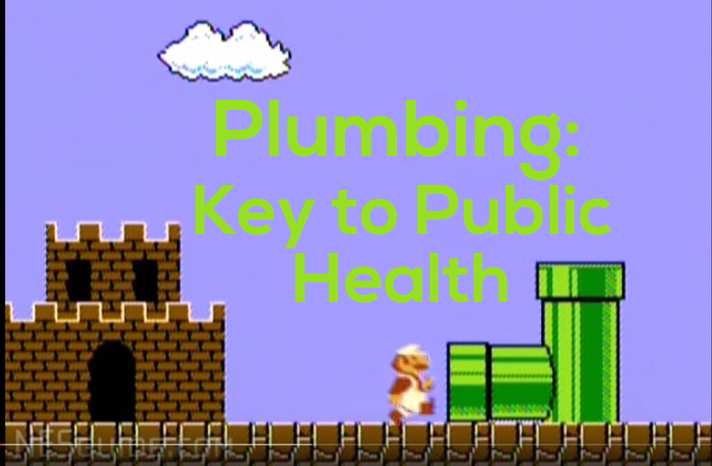What are some humanity’s greatest inventions? While the printing press, air travel, telephones, and computers are all amazing inventions, there is another invention that people use every single day that has saved millions of lives: modern plumbing. Without modern plumbing, it would not be possible for people to live in cities without suffering from diseases like dysentery, cholera, and typhoid fever.

The Oregon Trail Diseases
If you have ever played the computer game Oregon Trail, you have heard of dysentery, cholera, and typhoid fever. These are just three of the diseases that people contract when drinking water is contaminated with disease infected fecal matter. Unfortunately, these are not extinct old-timey diseases. People in developing countries still suffer from and die from these diseases today. Why are people in developed areas like the United States and Europe safe from the Oregon Trail diseases while people in India still suffer from and die due to dysentery, cholera, and typhoid fever? Is the answer vaccines? While vaccines play a critical role in preventing the spread of disease, adequate plumbing and sanitation is the best way to protect people from water borne and waste related diseases. Access to cleaning running water is also key to preventing other diseases and infections like pneumonia.
How Does Water Become Contaminated?
Let’s say that your community gets its water from a well. Your community disposes of its bathroom waste in a large pit. If the waste from the pit seeps into the ground water near your well, the well water will become contaminated. Then when the community drinks the water, they will be exposed to any diseases in the waste pit. Communities that get their water from lakes, steams, and rivers can also face contamination either from latrine seepage or people directly urinating, defecating, or disposing of human waste in the water supply. Modern plumbing prevents disease by keeping clean drinking water safe from human waste and effectively transporting the human waste to treatment plants. Plumbing is more then the fixtures you see in your home; it is the entire system from a reservoir to home plumbing to sewers to waste treatment and release into rivers or the ocean.
Modern Plumbing
A working toilet and sink seems basic, but is one of the best ways to prevent the spread of disease. Modern plumbing means that people do not have direct contact with human waste; it goes strait into the toilet and flushes away. Compared with hauling waste away in chamber pots or buckets, this dramatically reduces the likelihood of contact. Running water in the bathroom also means that people can wash their hands immediately after using the bathroom. According to washadvocates.org, hand washing with soap can reduce the incidence of childhood diseases by approximately 45 percent. WASH Advocates is a nonprofit, nonpartisan initiative dedicated to helping solve the global safe drinking water, sanitation, and hygiene (WASH) challenge.

Who Still Needs Safe Plumbing?
Many areas of India and Africa lack modern, effective plumbing, or any plumbing at all. According to washadvocates.org, 2.4 billion people do not have access to a toilet and 663 million people do not have access to clean drinking water. People who live in these areas face the labor-intensive task of finding and hauling water. In many places in Africa, women walk miles each day just to get small amounts of contaminated water. Children in these areas have many incidences of diarrheal diseases each year, which hurts their overall health and chances for survival. Without access to a toilet, people often have to defecate in fields, which can cause food contamination. Going to the bathroom outdoors in fields, woods, and jungles also exposes the individual to immediate personal dangers like snakebites and sexual assault.
Besides waste related diseases, lack of indoor plumbing indirectly causes other diseases as well. Imagine not having convenient, warm water at your bathroom and kitchen sinks. How often would you wash your hands? How much more difficult would caring for children, washing dishes, laundering clothes, and general cleaning become? Performing basic cleaning and bathing keep people healthy. Without access to water, all sorts of infections and diseases are more common. Some areas in the United States such as remote parts of Alaska lack indoor plumbing. People and especially children that live in these areas without indoor plumbing have high rates of pneumonia and other respiratory diseases, likely due to reduced hand washing and cleanliness. According to the Washington Post, 1.6 million American households lack a flushing toilet. The homes are located in remote rural areas, Alaska, and Indian reservations.
Our Excellent Plumbing
In the United States, we are fortunate to have modern plumbing and sanitation. In the Bay Area, we are lucky to have access to the clean, high quality water of the Hetch Hetchy Reservoir. Our access to safe and reliable water and plumbing keeps our society safe and healthy. For information on plumbing and sanitation worldwide, see http://www.washadvocates.org.


